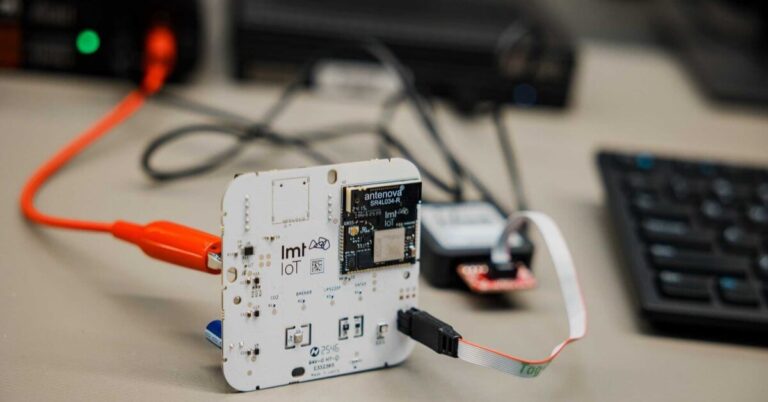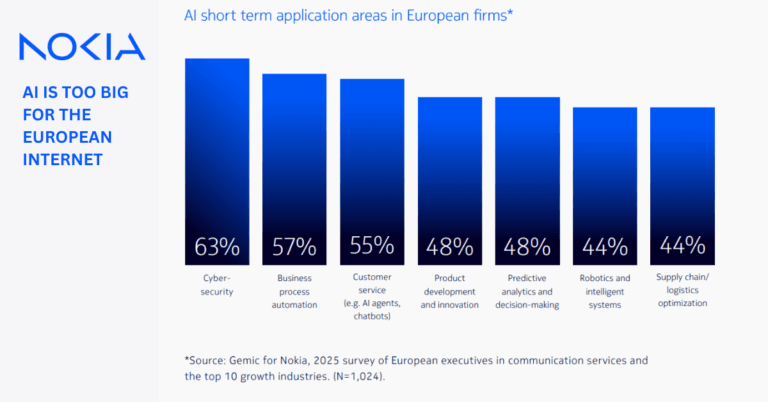Why Hospitals Need a Dual-Network 5G Strategy
Modern hospitals are data-intensive environments. From real-time telemetry to AI-assisted diagnostics, today’s clinical systems demand more than legacy networks can provide. Patients expect strong mobile signals, staff need uninterrupted access to digital tools, and devices—from smart beds to robots—constantly push and pull data.
To meet these challenges, Verizon Business is deploying a dual-network solution that combines neutral host coverage for general connectivity with a dedicated private 5G layer for mission-critical hospital operations. This two-tier architecture is being adopted by leading healthcare providers, including AdventHealth and Tampa General Hospital, marking a new chapter in hospital networking.
The Network Pressures Facing Modern Healthcare Facilities
Hospitals face three overlapping network challenges:
- Rising data volumes and device density: EHRs, imaging, and smart devices generate terabytes of traffic daily. Connected equipment and mobile workflows are now standard, not optional.
- Diverse user groups with unique needs: Networks must simultaneously support patients, guests, contractors, clinicians, and devices—each with different performance, privacy, and access requirements.
- Legacy infrastructure limits modernization: Distributed Antenna Systems (DAS) are expensive to scale and often locked to specific carriers. Wi‑Fi can’t always deliver the reliability, latency, and QoS that medical applications require.
At the same time, hospitals must adhere to strict regulatory and security standards such as HIPAA, manage data sovereignty, and build networks that don’t disrupt critical care.
How Verizon Combines Private 5G and Neutral Host for Hospitals
Verizon’s solution addresses these pain points with a shared, on-prem infrastructure that enables:
- Neutral host cellular access for patients, visitors, and non-clinical staff
- Private 5G for high-assurance clinical and operational applications
This approach gives hospital IT leaders granular control over traffic segmentation and policy management—enabling role-based access and isolation of sensitive data flows.
Key features include:
- Dedicated bandwidth for hospital systems
- Support for AI-driven applications
- Low-latency connections for real-time services
- Seamless public mobile coverage across the entire campus
Ericsson’s platform underpins the radio access network (RAN), private 5G core, and lifecycle tools, ensuring the solution is robust and scalable.
Case Studies: AdventHealth and Tampa General Hospital
Two leading health systems—AdventHealth and Tampa General Hospital—illustrate how this model is delivering real-world impact.
AdventHealth: Enhancing Mobility Across a Smart Campus
AdventHealth is building a next-generation campus that blends healthcare with hospitality. The neutral host layer ensures guests and non-clinical teams have reliable mobile coverage across waiting areas, retail zones, and community spaces. Meanwhile, the private 5G network supports clinical-grade applications such as:
- Real-time location services (RTLS)
- Smart beds and telemetry
- Secure communications between care teams
The architecture also gives the IT team the flexibility to introduce new medical technologies without re-architecting the network.
Tampa General Hospital: Replacing Legacy DAS with a Future-Ready Platform
Tampa General’s network transformation began as a DAS replacement project. As the hospital expanded and upgraded its EHR platform, gaps in connectivity became clear. Verizon deployed a neutral host network that consolidated coverage across multiple buildings while removing the complexity of multi-carrier DAS systems.
The site now includes a dormant private 5G core, which can be activated as use cases like academic research, clinical AI pilots, and remote diagnostics scale over time.
Key Technologies Powering Verizon’s Hospital 5G Architecture
The dual-network model includes the following key technology layers:
- Neutral Host Infrastructure: Shared RAN supporting multi-operator connectivity. This eliminates the need for hospitals to negotiate individual carrier deployments or expand outdated DAS systems.
- Private 5G Core: A dedicated, on-prem core provides deterministic performance, data control, and traffic segmentation. It can remain dormant until needed, enabling staged investment.
- RAN, Spectrum, and Edge: Onsite radios and flexible spectrum licensing accommodate local regulatory requirements. Integration with edge computing ensures data locality for AI and latency-sensitive workloads.
- Policy and Orchestration: Traffic is segmented by user role (e.g., clinician, patient, device). Policies enforce QoS, zero trust security, and service-level priorities tied to clinical operations.
This entire stack runs on Ericsson’s lifecycle management platform, enabling continuous updates and consistent performance.
Benefits of Dual-Network 5G in Clinical Environments
The combined neutral host + private 5G model delivers measurable improvements across hospital operations:
- Stronger indoor mobile coverage for all users
- Dedicated connectivity for critical workloads
- Support for AI-powered diagnostics, imaging offload, and autonomous systems
- Enhanced network security and segmentation aligned with HIPAA and other standards
- Reduced cost and complexity compared to expanding legacy DAS or deploying separate networks
Hospitals also gain the agility to scale services incrementally—enabling a “pilot-to-production” path for private 5G.
How Dual-Network 5G Aligns with Healthcare Trends
This solution reflects a broader shift in healthcare IT toward mobile-first infrastructure that prioritizes clinical performance, staff experience, and patient satisfaction.
Key trends this approach supports:
- Growth in AI-powered clinical decision tools
- Expansion of connected medical devices
- Maturity in digital twin and RTLS deployments
- Enhanced safety and logistics via robotics and video analytics
Similar models are emerging in retail, education, and transportation—but the stakes in healthcare are higher, making assurance-grade performance essential.
Verizon’s Role in Designing Scalable Hospital Networks
Verizon Business owns the end-to-end delivery of the solution:
- Network design and architecture
- Integration with existing hospital systems (EHR, CMMS, RTLS)
- Support for SLAs based on clinical KPIs like uptime, latency, and onboarding speed
Verizon also offers flexible commercial models—including phased rollouts and as-a-service deployments—to reduce risk and align spending with value realization.
Ericsson and Hospital Teams Drive Digital Health Innovation
- Ericsson: Provides the RAN, private 5G core, and operations platform. Also ensures compliance with healthcare-grade reliability and software lifecycle management.
- Hospital CIOs & IT Teams: Define use cases, integration priorities, and governance models. They play a key role in aligning clinical needs with network capabilities.
- Clinical Champions: Physicians, nurses, and operations leaders help validate use cases and build trust in new applications powered by private 5G.
Hospital 5G Rollouts: Timeline and Next Steps
- AdventHealth: Live with both neutral host and active private 5G.
- Tampa General Hospital: Live with neutral host; private 5G core is staged for future activation.
Verizon is showcasing the model at HLTH USA 2025, with strong interest from CIOs across regional and national health systems.
- Q1 2025: Strategy announced
- Q2 2025: Site planning and stakeholder alignment
- Q3 2025: Deployment begins at pilot sites
- Q4 2025: AdventHealth and Tampa General go live
- 2026–2027: Expansion to multi-campus health systems
What Verizon and Partners Say About Private 5G in Hospitals
“Verizon pioneered an innovative and resourceful approach to enterprise networking with their Neutral Host and Private 5G combo solution, which efficiently covers nearly any premises that requires both public and private data needs. Hospitals are a prime example, with different populations to serve, a plethora of devices to connect, unique front-of-house and back-of-house data sovereignty requirements. It’s a rare example of true solution leadership that fills an immediate need and has the flexibility to evolve,” said Paul Hughes, Research Director, IDC.
“Our patients’ experience onsite and the integrity of their data are of utmost importance, which made it a no-brainer to switch to Verizon’s combination Neutral Host and Private 5G Network,” said Scott Arnold, Executive Vice President and Chief Digital and Innovation Officer, Tampa General Hospital. “Our connectivity is much more responsive and reliable, allowing us to get the information we need when we need it. As a result, our operations run more smoothly, and most importantly, the care we deliver is better than ever.”
“As digital adoption continues to increase in the healthcare sector, providers require scalable network solutions with access across multiple sites and use cases,” said Jennifer Artley, SVP of 5G Acceleration, Verizon Business. “Verizon’s network helps patients, guests, and hospital staff maintain connectivity, operations, and, most importantly, top-notch care, without any headaches or extra steps.”
“Healthcare is undergoing rapid digital transformation, and advanced networks are essential to this evolution,” said Hannes Ekström, Senior Vice President and Head of Customer Unit Verizon for Ericsson Americas. “Together with Verizon, we’re enabling AI-driven innovations that help hospital staff enhance patient care, streamline operations, and future-proof healthcare facilities with high-performance 5G.”







































